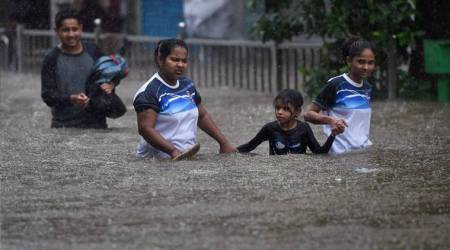 The total rainfall in the country, this year, might also vindicate the department’s forecast of a “normal” monsoon.
The total rainfall in the country, this year, might also vindicate the department’s forecast of a “normal” monsoon.
In April, the India Meteorological Department’s first long-range forecast predicted a “normal” monsoon. The department reiterated this forecast in early June. But the monsoon this year has been all about inordinate amounts of rainfall. Parts of Assam, Bihar and Gujarat are submerged in historic levels of floodwater. On Tuesday, Mumbai was lashed by 315 mm of rainfall — its worst deluge since the catastrophic floods of July 26, 2005. Two weeks ago, Bengaluru experienced its heaviest downpour in 120 years. The Karnataka capital, though, was back to normal in two days and the Met department has said that the worst is over for Mumbai. The total rainfall in the country, this year, might also vindicate the department’s forecast of a “normal” monsoon. But the weather patterns during the rainy season — days of intense downpour sandwiched between spells of dry weather — raise questions about our understanding of the monsoon, as well as about the ways in which we prepare for and deal with floods.
More than 100 districts have received over 100 mm of rainfall in a day. This means that people in these places have had to contend with a fortnight’s rainfall in a day — and at places much more than that. Mount Abu, for example, got over half its annual rainfall in two days. Bengaluru got about 30 per cent of its monsoon rainfall on one day. Chandigarh received nearly 15 per cent of its annual rainfall in a few hours in the third week of August. Climate scientists have been issuing warnings about such extreme rainfall for more than a decade. A 2013 Intergovernmental Panel on Climate Change report warned that Mumbai remains vulnerable to rainfall of the kind that led to the 2005 floods. “About 2.8 million inhabitants in Mumbai are exposed to coastal flooding, but this figure is projected to increase to 11 million by 2070 with exposed assets growing from $ 46.2 billion to $ 1.5 trillion in the same period,” the report noted. It pointed out that the indiscriminate destruction of wetlands — sponges that soak up excess rainfall — has compromised the city’s capacity to deal with floods. That holds true for Bengaluru, Guwahati, and several other cities of the country.
There has been little inclination to place the restoration of wetlands at the centre of flood control programmes. Flood governance in the country has not gone beyond ad hoc relief measures and building embankments. The floods in Assam and Bihar this year have shown — for the umpteenth time — that embankments are no bulwarks against the raging rivers. Of course, what is true for Assam and Bihar may not be so for Mumbai or Bengaluru. But it’s also clear that we require fresh thinking on how to prepare for the monsoons and deal with floods.

